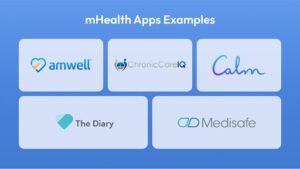How IoT in Healthcare is Changing the Diagnosis and Treatment of Diseases
Robotic surgeons and smart hospitals are examples of how technology is being used in healthcare to enhance patient care and efficiency. By bringing medical IoT gadgets that streamline physicians’ and healthcare professionals’ processes, the Internet of Things is also improving patient care.
Healthcare organizations are embracing IoT technologies to enhance patient outcomes and optimize medical procedures. This involves integrating Internet of Things technologies with hardware and software, including websites for healthcare. Our mission is to provide knowledge about the advantages, difficulties, and other pertinent aspects of IoT technology application in healthcare.
Why IoT is Beneficial for Healthcare
The Internet of Things (IoT) in healthcare is the idea of using the global web to link medical systems, equipment, and devices in order to gather and share data. Afterwards, this information may be used to advance medical innovation, optimize operational effectiveness, and provide better patient care.
Remote monitoring is a major advantage of IoT in healthcare. This enables remote monitoring of patients’ vital signs, medication compliance, and general health state by healthcare professionals, enabling more prompt and individualized treatment. Wearable technology, such fitness trackers and smartwatches, may monitor a patient’s heart rate, activity level, and sleep habits in real time.
Medical practitioners can then analyze the data these gadgets collect. Integration of data from several sources, including imaging systems, laboratory findings, and electronic health records, is another benefit of IoT in healthcare. This makes it possible to see a patient’s medical history and present state more thoroughly, which improves diagnostic and treatment choices. IoT in healthcare may also assist to increase operational efficiency and simplify procedures. By automatically updating inventory levels and sending notifications when maintenance is needed, for instance, linked medical devices may lower the risk of equipment downtime and guarantee that healthcare facilities are constantly supplied with critical supplies.
Healthcare professionals’ practices and the way patients are cared for might be completely transformed by the use of IoT in the industry. Healthcare companies may improve patient outcomes, maximize operational efficiency, and promote medical innovation by using technology to collect, evaluate, and distribute data. You can discover how to develop a hospital management system to further enhance these capabilities.
Internet of Medical Things: The Basics You Should Consider
The IoMT is a network of interconnected medical devices, software applications, and health systems that collect, transmit, and analyze patient data in real-time.By allowing remote monitoring, individualized treatment regimens, and better patient outcomes, this technology is completely changing the healthcare sector. Devices that fall under the category of IoMT include insulin pumps and pacemakers, as well as wearable fitness trackers.
The apps capable to cooperate with the IoMT devices are represented on the below image:
IoMT devices have the potential to assist patients in dealing with diseases like diabetes or heart disease, in addition to tracking physical activity and monitoring vital signs. By giving real-time data on blood sugar levels, heart rate, and medication adherence, these gadgets help healthcare professionals make better treatment choices.
Major Challenges of IoT in Healthcare and How to Solve Them
By linking medical equipment, sensors, and other devices to enhance patient care and optimize processes, the Internet of Things (IoT) has the potential to completely transform the healthcare sector. But there are a lot of difficulties involved in integrating IoT in the healthcare industry. The top biggest obstacles to IoT in healthcare are listed below.
One of the biggest concerns surrounding IoT in healthcare is data security and privacy. With the vulnerable patient information being transmitted between devices, there is a higher risk of data breaches and cyber attacks.
Ensuring that appropriate security measures are implemented is important for healthcare organizations to safeguard patient data from unauthorized access.Healthcare institutions should make significant investments in strong cybersecurity solutions to safeguard patient data when it comes to data security and privacy concerns. Multi-factor authentication, encryption, and frequent security audits to find flaws are a few examples of this.
Let’s also talk about interoperability. This is the smooth transmission of data and communication across various systems and devices. Ensuring interoperability is crucial for giving healthcare professionals accurate and timely information since different hardware and software are utilized to monitor patients and manage their treatment.
Healthcare organizations may collaborate with manufacturers to guarantee that their systems and equipment can successfully interact with one another in terms of interoperability. Utilizing standardized protocols and interfaces to enable data transmission across various hardware and software programmes may be one way to do this.
Moreover, scalability is another challenge that healthcare organizations face when implementing IoT solutions. As the number of connected devices increases, the infrastructure and bandwidth needed to support these devices must also be able to scale accordingly. Healthcare organizations need to plan for scalability from the outset to avoid issues with network congestion and performance degradation.
Healthcare companies should carefully design their IoT solutions to support future expansion in order to handle scalability challenges. This might include making investments in cloud-based services or other scalable infrastructure that can handle an increase in the number of linked devices without sacrificing functionality.
Even though IoT has a lot to offer the healthcare sector, overcoming these obstacles is necessary for its effective adoption. Healthcare organizations may use the IoT to enhance patient care and streamline operations in a safe and effective way by emphasizing data security and privacy, guaranteeing interoperability, and preparing for scalability.
Conclusion
IoT in healthcare is bringing in a new age of never-before-seen connectedness, efficiency, and innovation in the medical industry by completely changing how patient care is delivered and the strategies used by healthcare professionals. We’ve outlined only the basics of its use, but if you want to know more, you can contact the skilled healthcare IT development provider. The provider’s experts can go further into the nuances of IoT adoption in the healthcare industry, providing customized solutions and knowledgeable advice to maximize your company’s IT setup and improve patient outcomes.






